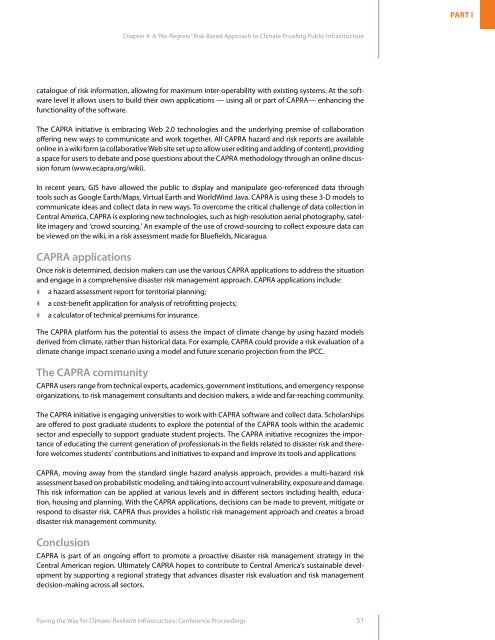Paving the Way for Climate-Resilient Infrastructure - UN CC:Learn
Paving the Way for Climate-Resilient Infrastructure - UN CC:Learn
Paving the Way for Climate-Resilient Infrastructure - UN CC:Learn
You also want an ePaper? Increase the reach of your titles
YUMPU automatically turns print PDFs into web optimized ePapers that Google loves.
PART IChapter 4: A ‘No-Regrets’ Risk-Based Approach to <strong>Climate</strong> Proofing Public <strong>Infrastructure</strong>catalogue of risk in<strong>for</strong>mation, allowing <strong>for</strong> maximum inter-operability with existing systems. At <strong>the</strong> softwarelevel it allows users to build <strong>the</strong>ir own applications — using all or part of CAPRA— enhancing <strong>the</strong>functionality of <strong>the</strong> software.The CAPRA initiative is embracing Web 2.0 technologies and <strong>the</strong> underlying premise of collaborationoffering new ways to communicate and work toge<strong>the</strong>r. All CAPRA hazard and risk reports are availableonline in a wiki <strong>for</strong>m (a collaborative Web site set up to allow user editing and adding of content), providinga space <strong>for</strong> users to debate and pose questions about <strong>the</strong> CAPRA methodology through an online discussion<strong>for</strong>um (www.ecapra.org/wiki).In recent years, GIS have allowed <strong>the</strong> public to display and manipulate geo-referenced data throughtools such as Google Earth/Maps, Virtual Earth and WorldWind Java. CAPRA is using <strong>the</strong>se 3-D models tocommunicate ideas and collect data in new ways. To overcome <strong>the</strong> critical challenge of data collection inCentral America, CAPRA is exploring new technologies, such as high-resolution aerial photography, satelliteimagery and ‘crowd sourcing.’ An example of <strong>the</strong> use of crowd-sourcing to collect exposure data canbe viewed on <strong>the</strong> wiki, in a risk assessment made <strong>for</strong> Bluefields, Nicaragua.CAPRA applicationsOnce risk is determined, decision makers can use <strong>the</strong> various CAPRA applications to address <strong>the</strong> situationand engage in a comprehensive disaster risk management approach. CAPRA applications include:a hazard assessment report <strong>for</strong> territorial planning;a cost-benefit application <strong>for</strong> analysis of retrofitting projects;a calculator of technical premiums <strong>for</strong> insurance.The CAPRA plat<strong>for</strong>m has <strong>the</strong> potential to assess <strong>the</strong> impact of climate change by using hazard modelsderived from climate, ra<strong>the</strong>r than historical data. For example, CAPRA could provide a risk evaluation of aclimate change impact scenario using a model and future scenario projection from <strong>the</strong> IP<strong>CC</strong>.The CAPRA communityCAPRA users range from technical experts, academics, government institutions, and emergency responseorganizations, to risk management consultants and decision makers, a wide and far-reaching community.The CAPRA initiative is engaging universities to work with CAPRA software and collect data. Scholarshipsare offered to post graduate students to explore <strong>the</strong> potential of <strong>the</strong> CAPRA tools within <strong>the</strong> academicsector and especially to support graduate student projects. The CAPRA initiative recognizes <strong>the</strong> importanceof educating <strong>the</strong> current generation of professionals in <strong>the</strong> fields related to disaster risk and <strong>the</strong>re<strong>for</strong>ewelcomes students’ contributions and initiatives to expand and improve its tools and applicationsCAPRA, moving away from <strong>the</strong> standard single hazard analysis approach, provides a multi-hazard riskassessment based on probabilistic modeling, and taking into account vulnerability, exposure and damage.This risk in<strong>for</strong>mation can be applied at various levels and in different sectors including health, education,housing and planning. With <strong>the</strong> CAPRA applications, decisions can be made to prevent, mitigate orrespond to disaster risk. CAPRA thus provides a holistic risk management approach and creates a broaddisaster risk management community.ConclusionCAPRA is part of an ongoing ef<strong>for</strong>t to promote a proactive disaster risk management strategy in <strong>the</strong>Central American region. Ultimately CAPRA hopes to contribute to Central America’s sustainable developmentby supporting a regional strategy that advances disaster risk evaluation and risk managementdecision-making across all sectors.<strong>Paving</strong> <strong>the</strong> <strong>Way</strong> <strong>for</strong> <strong>Climate</strong>-<strong>Resilient</strong> <strong>Infrastructure</strong>: Conference Proceedings 51
















